Mandalay was founded by King Mindon in 1857, and the majority of the monuments there including Mandalay palace, the city walls, pagodas, and monasteries were built in that year or soon after. The city took its name from the Mandalay Hill which is situated at the north-east comer of the present town. The hill has for long been a holy mount, and tradition has it that the Buddha on his visit with his disciple Ananda had prophesied that in the 2400th year of his religion (1857 A.C.) a great city, the metropolis of Buddhism, would be founded at its foot. King Mindon fulfilled the prophecy by shifting his capital from Amarapura to the site of the present city. The classical name of the city is Ratanapunja. In the transition of the development of the tourism industry, Mandalay has slowly become one of the main attraction to visit in most Myanmar tour packages.
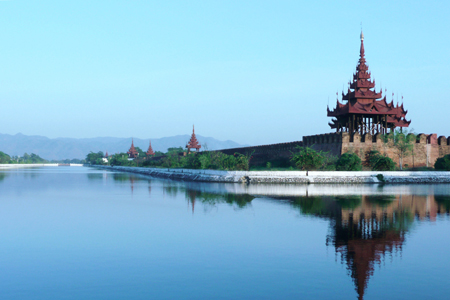
The monuments of Mandalay, just over a century old, scarcely possess any antiquarian interest. But viewed as representing the last of a long series of structures built by succeeding dynasties at the numerous capitals of Myanmar in gorgeous splendor their interest as a silent witness of an order of things which have now passed away forever becomes quite apparent. At the same time with the construction of the palace, foundations were laid for the building of the city wall and moat, the Atumashi or Incomparable monastery, the Kuthodaw Pagoda, the Thudhamma and Pahtan zayats (congregation halls) and the Library.
The fortified city is in the form of a square each side of which is 10 furlongs in length. A battlemented wall of brick and mud mortar has a total height of 25 feet and is backed by an earthen rampart. There are 12 gates, three on each side, at equal distances from each other and surmounted by pyatthats or pavilions of wood. Together with a pyatthat at each comer of the wall and 32 smaller intermediate pyatthats these total 48 in number. The moat averages 225 feet wide and 11 feet deep, surrounding the city. Of the five original wooden bridges spanning over the moat four lead to the principal or main gates. The palace occupied the central spot in the city. It was removed from Amarapura and was reconstructed at Mandalay. It consisted of numerous wooden buildings, many of them highly carved and gilt, on a high platform enclosed by a brick wall. King Thibaw added a few masonry structures. All these were destroyed by fire during the last war. However, a replica of the Lion Throne survived the war as it was removed from the Hluttaw or Supreme Court which was outside the palace complex to be deposited in the Indian Museum at Calcutta soon after the annexation of Upper Myanmar. This throne was restored to Myanmar after independence and is now exhibited in the National Museum at Yangon. View of moai and gateway of Mandalay fort.
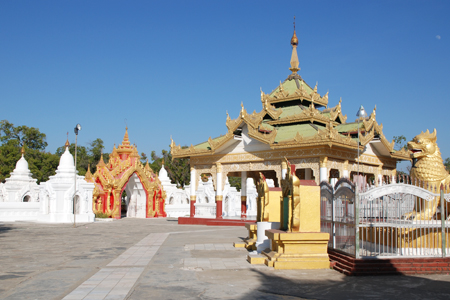
The Tooth Relic Tower and the Clock Tower lie to the east of the palace platform. North of the Clock Tower are the mausoleums of which King Mindon’s tomb is the most important. The Royal Mint and the Sabbath Hall are also close by. These are masonry structures and in the latter are remnants of contemporary mural paintings. Near the clock tower are two inscription sheds housing more than 600 inscribed stones being original lithic documents collected by Bodawpaya. They were removed for proper preservation from Amarapura to the present site just before the second world war.
Beneath the shadow of the Mandalay Hill lies the Kyauktawgyi Pagoda which was completed in 1878. It contains an image of the Buddha carved out of a single block of marble from the mines of Sagyin, a few miles to the north of Mandalay. The carving of the image was completed in 1865 and the dedication ceremony was performed amidst great rejoicing, the king himself having attended the festivities with pompous pageantry.
On the hill, itself are numerous religious buildings. There stands a huge image known as the Shweyattaw, representing Buddha pointing towards the palace as the future center of the capital. Many other pagodas, shrines, covered steps, etc., are the works of a very pious hermit, the late Rev. U Khanti who won great public Inscriptions at Sandamuni Pagoda, support to carry out such meritorious Mandalay.
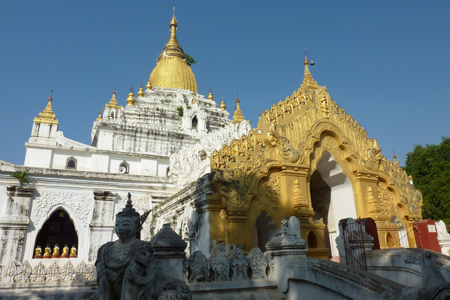
The Kuthodaw or Maha Lawkamarazein Pagoda lies to the east of the Kyauktawgyi Pagoda. It was built in 1857 by Mindon on the model of the Shwezigon Pagoda at Bagan. Its distinctive feature is the collection of 729 stone slabs on which are inscribed the whole of the Buddhist scriptures. King Mindon convened the Fifth Great Synod for the Buddhist canon and the authorized version of the Tripitaka approved by the Synod was inscribed on the stone slabs each of which is housed in a masonry shrine within the precincts of the pagoda. This collection is unique in the Buddhist world and is highly prized by all oriental scholars. To the south of the Kuthodaw pagoda lies the remains of the Atumashi or Incomparable Monastery built by Mindon in 1857 at a cost of five hundred thousand rupees. The building was of wood covered with stucco on the outside and its peculiar feature was the superstructure of five graduated rectangular terraces instead of the customary pyatthats or multiple roofs. In it was enshrined a huge image of Buddha and four sets of Tripitaka in large teak boxes. The whole, building together with its contents was burnt in 1890. What now remains of the magnificent structure are the masonry balustrade and staircases with elaborate stucco carvings.
Close to the east of the Atumashi Monastery is the Shwenandaw Monastery which attracts any visitors from Mandalay tour. It was built by King Thibaw, in 1880, mainly of materials obtained by dismantling the apartment occupied by Mindon. The whole building was heavily gilt and adorned with glass mosaic and exquisite wooden carvings. The building has considerably deteriorated but the carvings within it, especially the Ten Great Jataka scenes remain well preserved. Restoration of this monastery is now being undertaken by the Archaeological Department.
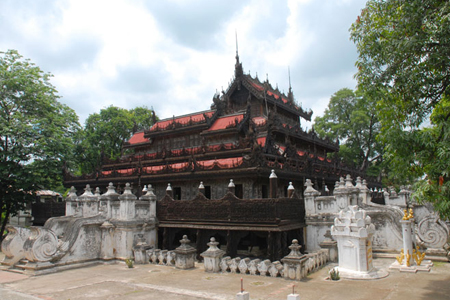
The vast area outside the fortified city is properly laid out in large squares. Among the notable monuments are the Mahamuni Pagoda, the Setkyathiha Pagoda, the Shwekyimyin Pagoda, and the Eindawya Pagoda. The Mahamuni lies in the southern quarter of the town in close proximity to the northern quarter of Amarapura. Enshrining the celebrated Mahamuni Image, it is also called the Payagyi (Great Pagoda) as well as the Arakan Pagoda as it was brought over from Arakan in 1784 during the reign of Bodawpaya. It is cast of bronze but the body has for long been lavishly gilded and has assumed an irregular outline. The image which is in the usual sitting posture is 12 feet 7 inches high. The original temple was damaged by fire in 1884. The present shrine which has a terraced roof of gilded stucco is of later construction, being built after the fire. In the inner courtyard are hundreds of stone slabs inscribed with copies of inscriptions recording religious endowments, the originals of which were collected by Bodawpaya. Within the precincts are six bronze figures, two of men, three of lions and one of a three-headed elephant, which was brought from Arakan at the same time as the Mahamuni Image was conveyed to Amarapura. They are part of the spoil which Bayinnaung took from Ayuthia in 1663 and later removed from Bago by the Arakanese King Rajagyi. Iconographically these bronze statues belong to Khmer style of art.
At the Setkyathiha Pagoda built on an elevated masonry, the platform is a huge Buddha image in bronze in the usually seated posture, measuring 16 feet by 8 inches in height. It was cast by King Bagyidaw at Innwa just before the outbreak of the first Anglo-Myanmar war in 1814, shifted to Amarapura by King Bagan in 1849 on the eve of the second war, and brought to Mandalay when the third war broke out.
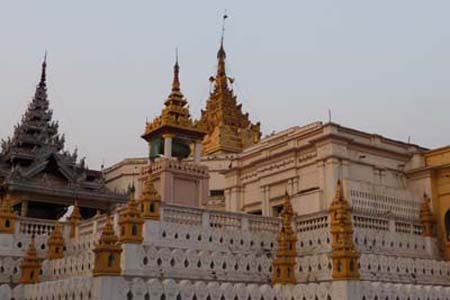
The erection of the Shwekyimyin pagoda dates back to the Bagan period. Prince Minshinzaw, son of the famous King Alaungsithu was exiled from Bagan. He settled down near the Aungbinle Lake to the east of the present city and engaged himself in the cultivation of rice. He built the Shwekyimyin pagoda and dedicated a Buddha image which is still to be seen in the sanctum. The pagoda is also noted as a repository of many Buddha images of gold, silver, and crystal which represent the collection of successive monarchs. These were salvaged from the palace at the time of the British occupation in 1885.
The Eindawya pagoda built by Bagan King marks the site where he resided before he ascended the throne. It is of fine proportion and gilt from top to bottom. In one of the shrines is housed a chalcedony image of Buddha said to have been brought from Bodhgaya in 1839.
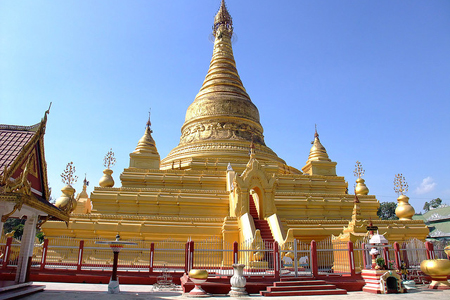
When King Mindon came to the throne he raised his younger brother Prince Kanaung to be crown prince as he had helped Mindon to overthrow King Bagan who was misruling the country. Prince Kanaung was very loyal and energetic. Mindon being a very pious King, he left the state affairs to Kanaung who endeavored to develop the country by establishing several factories and sending state scholars abroad. However, his ambitious schemes were disrupted as he was assassinated together with a few other princes when Myingun Prince revolted in 1866. The Sandamani Pagoda was built at the spot where Kanaung Prince fell. It contains an iron image of Buddha cast by Bodawpaya in 1802 and removed from Amarapura by Mindon in 1874. Within the precincts is a large collection of marble slabs inscribed with the commentaries on the Buddhist canon, the dedication of which was sponsored by the Rev. U Khanti.
There were palace intrigues even while Mindon was on his death bed. Finally, the Dowager Queen and senior ministers chose a very young prince Thibaw, to succeed Mindon. He ascended the throne in 1878 and was married to Supayalat, the younger daughter of the Dowager Queen. His rule came to an end in 1885 when the British annexed Upper Myanmar. Thibaw built the Man-Aung Yadana Pagoda at Mandalay in 1881 after the model of the Kuthodaw. Both the historical and architectural interest lies in its being the shrine built by the last king of the Konbaung dynasty, and in its constituting the last link in the long series of religious edifices marking the sites of the capitals of Myanmar.
Mandalay had lost its glory and prestige but it still remains the pride of the country of being the fountain-head of Myanmar’s spiritual life and the heart-center of Myanmar culture.

